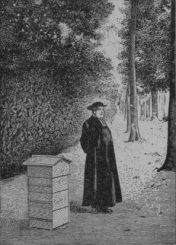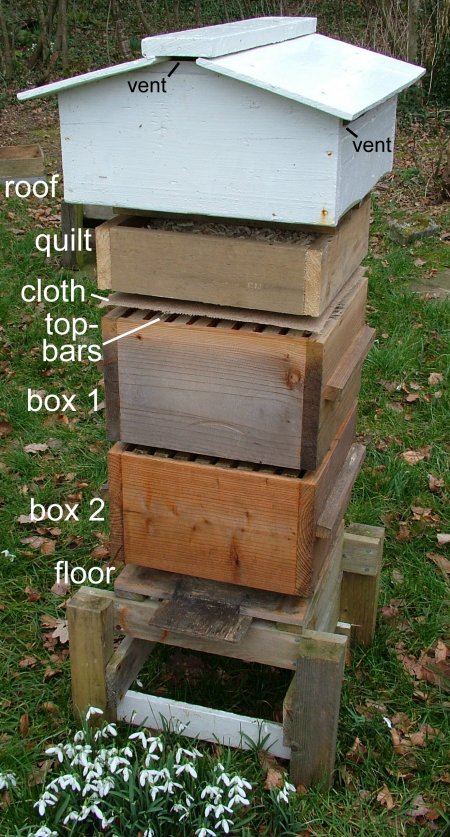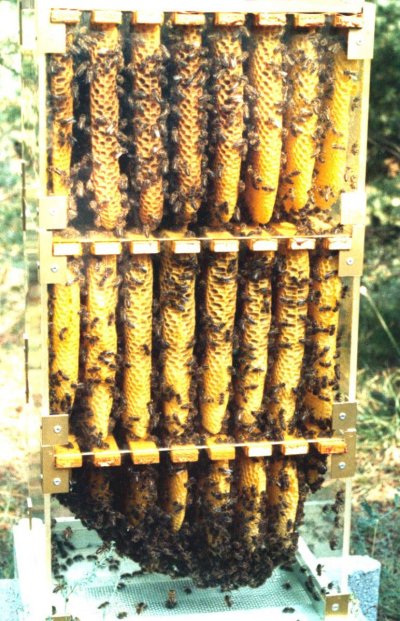
Warré plans
Warré methods
Warré modifications
Warré precursors
Groups / Fora
Google e-group
Biobees.com
forum
Abbé Warré's book
Beekeeping for All:
Original site:
warre.biobees.com
Mirror site: mirror.warrebeekeeping.org
These pages are dedicated to beekeeping using the hive developed by Abbé Émile Warré (1867-1951) and any of its modifications. Responding to the obvious decline in beekeeping in France since his youth, Warré experimented with some 350 hives of various designs with the aim of producing a hive that was simple, economical, bee-friendly and assured a surplus for the beekeeper. The result was his People's Hive (Ruche Populaire) whose construction and operation he described in his book Beekeeping For All (L' Apiculture Pour Tous, 12th edition)1.
Warré's hive comprises tiers of identical boxes fitted with top-bars, but no frames. Its essential design and usage features can be summarised as follows:
- hive-body box internal dimensions 300 x 300 x 210 mm, with projecting handles,
- eight 36mm centred 24mm wide top-bars resting in rebates in each box (NO FRAMES),
- wax starter strips under each top bar (NO FOUNDATION),
- flat floor, notched with a 15 x 120mm entrance, alighting board,
- coarse weave cloth covering the top-bars of the top box,
- 100 mm high 'quilt' boxed with wood and filled with straw, sawdust, wood shavings etc., retained with a cloth,
- gabled roof containing a ventilated 'loft' and separated from the quilt by a mouse-proof board,
- the bees build natural comb in the first (top) box and extend this downwards into further boxes,
- new boxes are usually added at the bottom (nadiring),
- one or more boxes of honey are harvested from the top after the main flow,
- the bees winter on two boxes of comb containing a minimum of 12 kg stores (France),
- honey is harvested by draining, or pressing, or by centrifuging combs in special baskets,
- at the spring visit, the hive is expanded by one or more boxes, containing starter strips or combs.
An important feature of Warré's method is that the hive need be opened, in the strict sense, only once a year, namely at harvest. The addition of boxes underneath (nadiring) in spring and later in the season does not constitute opening the hive in the sense that its heat and atmosphere is let out. The importance of the retention of nest scent and heat (Nestduftwärmebindung) for bee health and productivity was discussed by Johann Thür in his book Beekeeping: natural, simple and successful (1946) which also presents Abbé Christ's (1739-1813) hive that is almost identical in concept to Warré's.
No frames
Even in early editions of Beekeeping For All, Warré advised against using frames as shown in the 5th edition:
'Nowadays, I recommend without hesitation the People's Hive with fixed combs, even for very large enterprises. [...] However, out of respect for the freedom of my readers, I will describe the People's Hive in its three forms: fixed comb, ordinary frames, open frames with closed ends.'2
This web site is premised on the 12th edition of Beekeeping For All which describes the top-bar version of his hive only. But, for the sake of completeness, we provide a translation of the pages of the 5th edition describing the two versions of his hive with frames, the latter having no bottom-bars.3 On a separate page devoted to frames, we list Warré's objections to them and compare his frame dimensions with those of two Warré hives currently used with frames.
Present day beekeeping with the Warré hive
The geographical focus of Warré beekeeping is France and the hive was also initially used in Belgium and Switzerland. The first in use in Germany and Russia were populated in 2006. An experiment was started with six modified Warré hives in Wales, UK, in 2007. In 2008, beekeepers in Canada, USA (including Alaska) and Spain made Warré hives in readiness for spring 2008. By late 2009, Warré beekeepers were also known in Australia, Austria, Brazil, Croatia, Estonia, Italy, Japan, Latvia, New Zealand, Poland, Romania, Serbia, Slovakia, Sweden and Uruguay. English, French and German sites and fora of Warré beekeepers and hive manufacturers can be reached via the 'Links' page.
An English language e-group for Warré beekeeping can be joined via https://groups.google.com/g/warrebeekeeping
There is Warré beekeeping thread in the forum at Top Bar Beekeeping with the Barefoot Beekeeper (www.biobees.com/forum/).
Plans for constructing an authentic Warré hive.
Complete newcomer to beekeeping?
Please read our page of advice for complete beginners.
Variants of the Warré hive
In France the Warré hive is variously referred to as Ruche Populaire, Ruch Warré, Ruche Écologique, Ruche Climatstable and Ruche Française. Many modifications have been introduced, some of which depart in varying degrees from Warré's intentions of simplicity, economy and bee-friendliness. However, some of the modifications may eventually prove to be necessary, for instance in climates other than that of France, or in areas where legislation requires combs to be easily movable. We therefore offer descriptions of these variants in separate pages accessible via the links below:
Roger Delon's Stable-Climate Hive (Ruche
Climatstable)
Jean-Marie Frèrès' & Jean Claude Guillaume's Ecological
Hive (Ruche Écologique)
David Heaf's modified Warré Hive Roof
The double Warré hive system of Jean-François Dardenne
Warré hive accessories by Marc Gatineau
David Croteau's hive base with sump and entrances in each box
Gilles Denis' half-frame (porte-rayon) and a discussion
of frames versus top-bars
Historical precursors of the Warré hive based on a similar
or identical concept


Left: 'Exploded' view of a Warré hive. The top-bar
cloth here is coarsely woven hessian.
Right: Marc Gatineau's transparent Warré hive on its third box. From http://www.apiculturegatineau.fr
Notes
1) Beekeeping For All by Abbé Émile
Warré is translated into English from the 12th edition of L' Apiculture Pour Tous
which is dated 1948. For details of this book and e-book click here.
The 5th edition (see note 2 below) is dated March 1923 and was published when Warré
was curé of Martainneville in the Somme, France. The 12th edition was published after he
had moved to Saint-Symphorien on the outskirts of Tours, France. We await information on
the publication date of the first edition of the book.
Original French of 12th edition of L' Apiculture Pour Tous:
1. transcribed as a PDF: http://www.apiculture-warre.fr/
2. as JPEG files of scans of each page: http://ruche.populaire.free.fr/apiculture_pour_tous_12eme_edition/
2) Translated from page 46 of L' Apiculture Pour Tous - Manuel-Guide Des Fixistes Et Des Mobilistes (Beekeeping For All - A manual for fixed comb and mobile frame beekeepers) by Abbé Warré, Bureau du 'Travail au Grand Air', 17 Rue Littré, 17 Tours, France, 5th edition, 1923. Downoad PDF of scan/OCR of 5th edition in French.
3) English translation of pages 60-71 of L' Apiculture Pour Tous - Manuel-Guide Des Fixistes Et Des Mobilistes (Beekeeping For All - A manual for fixed comb and mobile frame beekeepers) by Abbé Warré, Bureau du 'Travail au Grand Air', 17 Rue Littré, 17 Tours, France, 5th edition, 1923. Download PDF.
These Warré pages are authored by David Heaf who is based in North Wales, UK. We thank Phil Chandler for offering space for these pages on his site biobees.com. Copy-editing by Cleartext. See also www.bee-friendly.co.uk for more pages on running Warré hives.